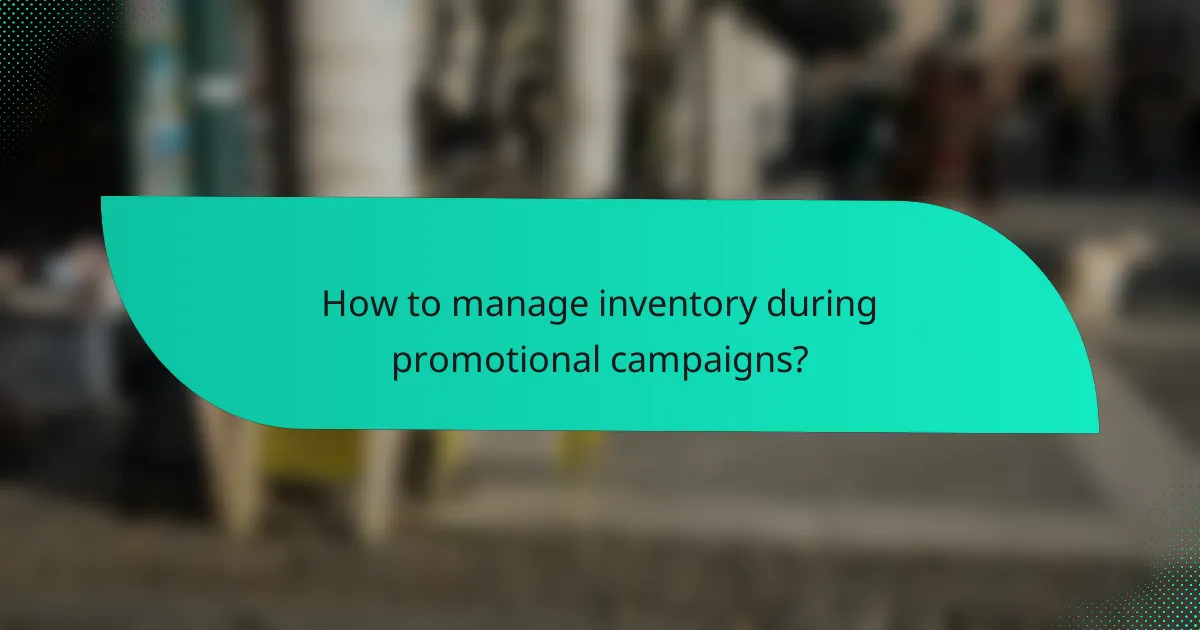Promotional campaigns play a vital role in shaping discount strategies, drawing customers in with attractive offers while boosting sales and brand image. However, they necessitate meticulous planning to ensure profitability and effective inventory management. Additionally, understanding the varying costs of advertising is essential for optimizing budget allocation and achieving a favorable return on investment.

How do promotional campaigns impact discounts in the UK?
Promotional campaigns in the UK significantly influence discounts by attracting customers through reduced prices and special offers. These campaigns can lead to increased sales and enhanced brand perception, but they require careful planning to balance profitability and inventory management.
Increased customer engagement
Promotional campaigns often lead to heightened customer engagement as consumers are drawn to limited-time offers and discounts. This engagement can manifest through increased foot traffic in stores or higher website visits, as customers seek out the best deals.
To maximize engagement, businesses should utilize various channels such as social media, email marketing, and in-store promotions. Engaging content, like countdown timers or exclusive deals for followers, can create a sense of urgency that encourages immediate action.
Higher sales volume
Discounts from promotional campaigns typically result in a higher sales volume, as customers are more likely to purchase when they perceive they are getting a good deal. This increase can be particularly pronounced during seasonal sales or special events.
However, businesses must consider the trade-off between increased sales and profit margins. It’s essential to analyze the cost of discounts versus the volume of sales generated, ensuring that the overall financial impact remains positive.
Brand loyalty enhancement
Effective promotional campaigns can enhance brand loyalty by creating positive customer experiences. When customers feel they are receiving value through discounts, they are more likely to return for future purchases.
To foster loyalty, brands should focus on consistency in their promotional efforts and ensure that discounts align with their overall brand message. Following up with customers post-purchase, perhaps through loyalty programs or feedback requests, can further solidify their connection to the brand.

What are the advertising costs associated with promotional campaigns?
Advertising costs for promotional campaigns can vary widely based on factors such as the chosen platforms, target audience, and campaign objectives. Understanding these costs is crucial for effective budget management and maximizing return on investment.
Cost-per-click (CPC) analysis
Cost-per-click (CPC) is a key metric in online advertising that measures the amount spent for each click on an ad. Advertisers typically bid on keywords, and the CPC can fluctuate based on competition and demand. For example, in competitive markets, CPC can range from a few cents to several dollars.
To optimize CPC, focus on targeting specific demographics and using relevant keywords. Regularly analyze performance data to adjust bids and improve ad placements, ensuring you get the best value for your spend.
Budget allocation strategies
Effective budget allocation is essential for maximizing the impact of promotional campaigns. Start by determining your overall marketing budget and then allocate funds based on the expected performance of different channels. For instance, if social media ads yield higher engagement, consider increasing their share of the budget.
Utilize a flexible budget approach, allowing for adjustments based on real-time performance metrics. Regularly review and reallocate funds to the most effective campaigns to ensure optimal use of resources.
Return on ad spend (ROAS)
Return on ad spend (ROAS) measures the revenue generated for every dollar spent on advertising. A higher ROAS indicates a more effective campaign. Generally, a ROAS of 4:1 is considered a good benchmark, meaning you earn four dollars for every dollar spent.
To improve ROAS, analyze which ads and channels perform best and focus your efforts there. Implement A/B testing to refine ad creatives and targeting strategies, ensuring that you maximize revenue while minimizing costs.

How to manage inventory during promotional campaigns?
Managing inventory during promotional campaigns is crucial for maximizing sales while minimizing excess stock. Effective strategies include real-time tracking, accurate demand forecasting, and strong supplier relationships to ensure you meet customer needs without overstocking.
Real-time inventory tracking
Real-time inventory tracking allows businesses to monitor stock levels continuously, which is essential during promotional campaigns. Implementing inventory management software can help provide instant updates on stock availability, enabling quick responses to fluctuations in demand.
Consider using barcode scanning or RFID technology to streamline the tracking process. This can reduce human error and improve accuracy, ensuring that you have the right amount of stock on hand to meet customer demand.
Demand forecasting techniques
Accurate demand forecasting is vital for anticipating customer needs during promotional campaigns. Techniques such as historical sales analysis, market trend evaluation, and customer behavior assessment can provide insights into expected demand levels.
Utilizing statistical models or machine learning algorithms can enhance forecasting accuracy. Aim for a range of estimates based on previous campaigns, adjusting for factors like seasonality or economic conditions to avoid stockouts or excess inventory.
Supplier relationship management
Strong supplier relationships are essential for effective inventory management during promotions. Establishing clear communication channels can facilitate quicker restocking and better negotiation terms, which is crucial when demand surges unexpectedly.
Consider developing agreements with suppliers that allow for flexible order quantities or expedited shipping during peak times. This can help maintain optimal inventory levels and ensure that you can respond to customer demand without delays.

What are the prerequisites for successful promotional campaigns?
Successful promotional campaigns rely on understanding your target audience and setting clear objectives. These prerequisites ensure that your marketing efforts resonate with potential customers and achieve desired outcomes.
Target audience identification
Identifying your target audience is crucial for tailoring your promotional campaigns effectively. This involves analyzing demographics, interests, and purchasing behaviors to create a profile of your ideal customer.
Consider using market research tools and customer surveys to gather data. For example, if you are targeting young adults, focus on platforms like social media where they are most active, and adjust your messaging to align with their values and preferences.
Clear campaign objectives
Establishing clear campaign objectives helps guide your promotional strategy and measure success. Objectives should be specific, measurable, achievable, relevant, and time-bound (SMART).
For instance, instead of a vague goal like “increase sales,” aim for “boost sales by 20% over the next three months.” This clarity allows for better planning and resource allocation, ensuring that your promotional efforts are focused and effective.

How do promotional campaigns affect display advertising strategies?
Promotional campaigns significantly influence display advertising strategies by altering ad placements, creative content, and overall budget allocation. These campaigns can enhance visibility and engagement but require careful planning to align with inventory management and advertising costs.
Ad placement optimization
Ad placement optimization is crucial during promotional campaigns as it determines where and how ads appear to maximize visibility. Advertisers should analyze audience behavior and preferences to select high-traffic placements, such as popular websites or social media platforms. Utilizing data analytics tools can help identify the best-performing placements, allowing for adjustments in real-time.
Consider testing different placements through A/B testing to determine which locations yield the highest engagement rates. For example, placing ads on mobile devices during peak shopping hours can lead to increased conversions. Avoid overcrowding ads on a single platform, as this can dilute effectiveness and lead to ad fatigue.
Creative content development
Creative content development is essential for capturing audience attention during promotional campaigns. The content should resonate with the target demographic, highlighting the benefits of the promotion while maintaining brand consistency. Engaging visuals and compelling copy can significantly enhance the effectiveness of display ads.
When developing creative content, consider incorporating strong calls-to-action (CTAs) that encourage immediate engagement. For instance, phrases like “Limited Time Offer” or “Shop Now” can create urgency. Additionally, ensure that the content is adaptable for various formats, such as banners or social media ads, to maximize reach across different platforms.

What emerging trends are shaping promotional campaigns in the UK?
Promotional campaigns in the UK are increasingly influenced by personalization and the integration of social media. These trends help brands connect more effectively with consumers, enhancing engagement and driving sales.
Personalization through AI
Personalization through AI tailors promotional messages to individual consumer preferences, significantly improving campaign effectiveness. By analyzing customer data, brands can create targeted offers that resonate with specific segments, leading to higher conversion rates.
For instance, retailers might use AI algorithms to recommend products based on past purchases or browsing behavior. This approach can increase customer loyalty and retention, as consumers feel more valued when they receive relevant offers.
However, brands must balance personalization with privacy concerns. Clear communication about data usage and obtaining consent is essential to maintain consumer trust.
Integration of social media platforms
Integrating social media platforms into promotional campaigns allows brands to reach wider audiences and engage with customers in real-time. Social media channels provide valuable insights into consumer behavior, enabling brands to adjust their strategies dynamically.
For example, using platforms like Instagram or TikTok for flash sales or exclusive promotions can create urgency and drive immediate sales. Brands should also consider user-generated content as a way to enhance authenticity and encourage community engagement.
To maximize impact, brands should ensure their messaging is consistent across all platforms and leverage analytics tools to track performance and optimize future campaigns.
